Yoko Ono - Music of the Mind
I am a great fan of Ono's work so it was a real pleasure seeing this exhibition, which by the way, was on quite a while ago.
Music of the Mind celebrates the work of artist and activist Yoko Ono. The exhibition explores Ono's conceptual practice, foregrounding ideas over objects, alongside her ongoing campaign for world peace. It takes its title from the artist's desire to stimulate the imagination. Ono notes: 'The only sound that exists to me is the sound of the mind. My works are only to induce music of the mind in people... In the mind-world, things spread out and go beyond time'.
The exhibition traces Ono's radical approach to art, language and participation, from her early 'instruction' pieces to her recent, large-scale installations. It covers seven decades of her expansive practice from 1955 to today. During this time, Ono moved between Japan, the US and the UK, before settling in New York in 1971.
Ono's art takes many forms. It includes scores, performances, objects, film, music, sound and events. In 1964, Ono published Grapefruit, her foundational book of instruction works. These concise texts, somewhere between poem and score, aim to unlock the mind. Instructions are presented throughout the exhibition, calling you to participate, often with others.
Ono invites one to realise her artworks - to construct paintings in the mind, perform inside a bag, play a game of chess and share memories and wishes. But, most importantly, she invites us to imagine. This collective call to action is a provocation to change the world, one wish at a time.
A dream alone is only a dream.
A dream you dream together is reality.
Yoko Ono.
It's been very difficult getting these posts together, given the nature of Ono's art, it's conceptual nature, which is very cerebral, but I hope I have done it justice.
There were two Wish Trees directly outside the exhibition galleries
where people left their wishes or read other people's.
Yoko Ono spent most of her childhood in Tokyo, also living for short periods in the US. Music and performance were an important part of Ono's family life and early education. She studied classical music and learnt how to translate everyday sounds into musical notation.
In the spring of 1945, during WWII, US Army Air Forces bombedf Tokyo. Ono, aged 12, was evacuated to the countryside, where food and other essentials were in short supply. Ono and her younger brother would lie on their backs, look up at the sky and escape in their imaginations. She remembers, 'we exchanged menus in the air and used our powers of visualisation to survive'. Ono describes this as 'maybe my first piece of art'.
In August, the US army dropped the first atomic bombs on the cities of Hiroshima and Nagasaki, bringing about Japan's surrender and ending the war. Ono notes that 'those experiences of the early days cast a long shadow in my life'.
Following the end of the war, Ono returned to Tokyo, later attending Gakushuin University as its first female philosophy student. She left after two semesters to join her parents in New York State. In 1953, she enrolled at the liberal arts college Sarah Lawrence, studying poetry and musical composition. During this period, Ono developed some of her earliest instructions.
These include:
Lighting Piece - 'Light a match and watch till it goes out'. Concept, 1955.
Ono was highly sensitive to sound. At times, she tried to block out the noises around her, hiding in a dark room at her parents' house and covering her ears with sanitary pads held by gauze. She repeatedly lit a match and watched it flicker and burn until the sounds in her mind disappeared along with the flame.
Ono was highly sensitive to sound. At times, she tried to block out the noises around her, hiding in a dark room at her parents' house and covering her ears with sanitary pads held by gauze. She repeatedly lit a match and watched it flicker and burn until the sounds in her mind disappeared along with the flame.
This concept was made up of 'inaudible sounds', 'sounds that reached the sky' and breaths', according to her then husbandf, Toshi Ichiyanagi. Ono noted: 'I wanted most things to be performed in the dark, thereby asking the audience to stretch their imaginations. A glimpse of things was seen by occasionally lit matches and torches. This went on for four hours'.
In 1956, aged 23, Ono moved to New York City, eloping with Japanese composer and pianist Toshi Ichiyanagi.
In July 1961, Ono's first solo exhibition opened at AG Gallery in Manhattan. It included more than fifteen Instruction Paintings which were realised through the participation of the artist, visitors or the environment. A few paintings had written instructions, but Ono communicated most by word of mouth. The gallery owned by George Maciunas who later founded Fluxus. An international network of artists and composers, Fluxus opened up definitions of what art could be, promoting 'living art', anti-art'. Ono played an active role in this.
Less than a year later, Ono exhibited more than 30 instructions for paintings at her exhibition in Tokyo. This time, her words were presented without accompanying canvases. It marked a decisive conceptual shift in her practice and the history of ideas based art. Paint was replaced by language and the viewer 'completed' the art work, either physically or simply in their mind. The idea took primacy over object. During this period, she also performed a series of concerts and events.
These Paintings comprise both an instruction and a physical artwork for the viewer to engage with. They are only an instruction. The idea itself is the work of art. This shift marked a key moment in the history of conceptual art.
'When people came, I took them around to each painting and explained what the function of each piece was... I remember Isamu Noguchi stepping on Painting to Be Stepped On with a pair of elegant Zohri slippers'.
Look through a phone book from the
beginning to end thoroughly.
List all the combinations of figures
you remember right after that.
Write five hundred telephone
numbers on a canvas in a space as
large as your palm. The numbers
can be overlapped with one another.
Also, the numbers can all be the
same.
Observe the drawing by enlarging it
with a microscope. Also, you may
take a picture of the drawing and
enlarge it to the size you prefer.
Go on transforming a square canvas
in your head until it becomes a
circle. Pick out any shape in the
process and pin up on the
canvas an object, a smell, a sound,
or a colour that came to your mind
in association with the shape.
1962 spring
Cut Piece:
Cut Piece:
Ono travelled to Tokyo in 1962 and ended up staying for two years. During this time, she connected with many artists, some of whom she had already met in the US. She was part of an artistic community challenging and subverting mainstream culture.
During this period, Ono met and married US filmmaker Anthony Cox. During this time she performed Cut Piece for the first time. She sat silently onstage wearing her best suit while the audience cut away pieces of her clothing.
During this period, Ono met and married US filmmaker Anthony Cox. During this time she performed Cut Piece for the first time. She sat silently onstage wearing her best suit while the audience cut away pieces of her clothing.
Cut Piece, 1964), filmed 21 March 1965
Ono kneels motionless onstage while audience members cut away pieces of her clothing with a pair of scissors. According to Ono, 'it was a form of giving, giving and taking. It was a kind of criticism against artists, who are always giving what they want to give. I wanted people to take whatever whey wanted'.
Cut Piece is one of Ono's most well-known works and she has performed it several times. She states that her performance in Paris in 2003 was 'against ageism, against racism, against sexism, and against violence'. She has also invited others to perform the work.
This piece has been performed by other artists as well, most notably Marina Abramovic where, at times, some members of the audience took too much, some reverting to violence and sexual abuse. You can see parts of that performance here
Before returning to New York in 1964, Ono held a farewell concert where she performed Cut Piece, Bag Piece and Striptease for Three. She explained: 'to strip means not to reveal to others but to discover something hidden in humans' and a 'stripping of the mind'. The idea of exploring one's self united many of the pieces Ono presented at her Japanese concerts.
In Bag Piece, one or more performers remove their shoes, enter a black bag onstage and carry out various activities while inside. This may include moving around, removing their clothes or even taking a nap. The movements of the performers within the bag create a fluctuating sculpture.
During the 1966 exhibition The Stone at Judson gallery in New York, viewers were invited to fill in a questionnaire that asked absurd, philosophical questions before entering the bag.
During the 1966 exhibition The Stone at Judson gallery in New York, viewers were invited to fill in a questionnaire that asked absurd, philosophical questions before entering the bag.
Ono said: 'By being in a bag, you show the other side of you, which is nothing to do with race, nothing to do with sex, nothing to do with you know, age, actually. Then you become just a spirit of soul. And you talk soul to soul ... I like that idea. To become something totally different'.
Drill a hole in a canvas and put your hand out from behind. Receive your guests in that position. Shake hands and converse with hands.
Shadow Piece, concept 1963, first performed 1966, (performance, instruction, pen, spotlight)
Please use the pencils provided to trace around another person's shadow, or your own, on the canvas.
Shadow piece
Put your shadows together until they become one.
Draw Circle Event, 1964-65, (print on paper, ink, pigment, mixed media, selection of 5 postcard responses sent by the following artists: Charlotte Morrman, Carolee Schneemann, George Maciunas, Ay-O, George Brecht)






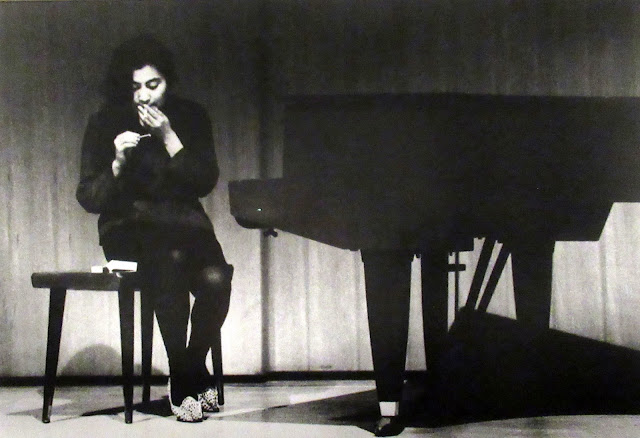







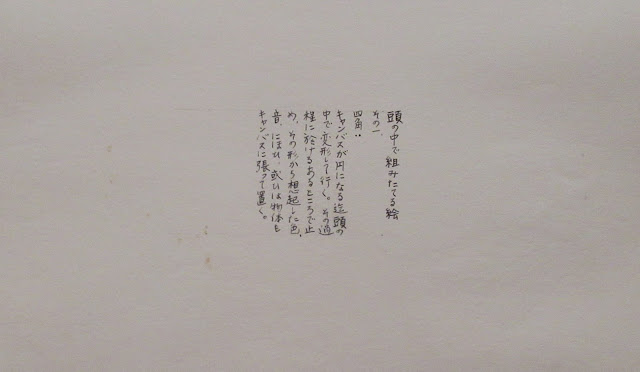



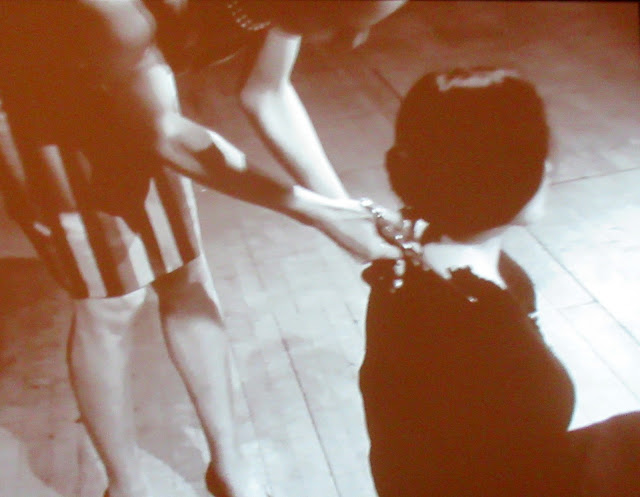

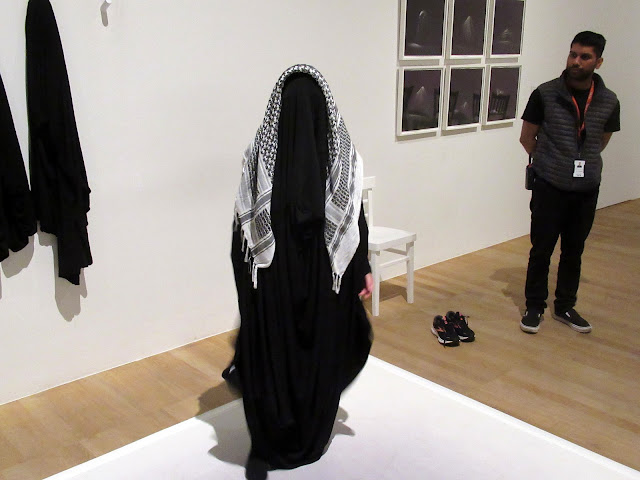





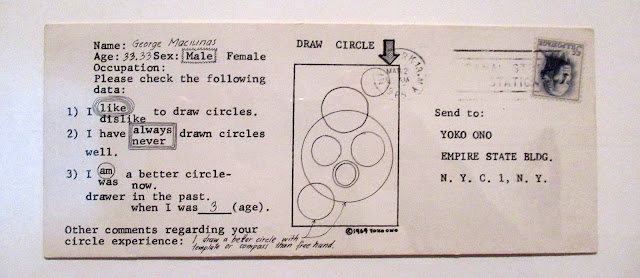
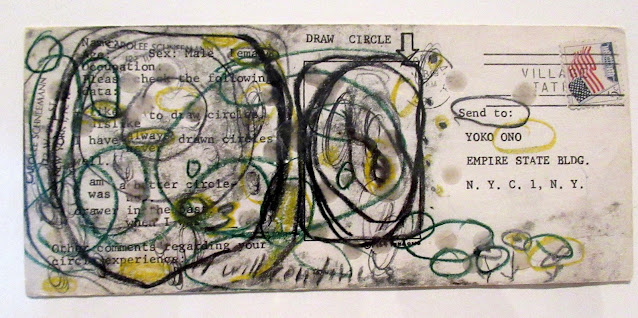
No comments:
Post a Comment